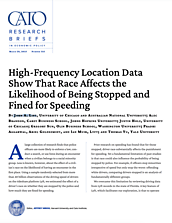A large collection of research finds that police officers are more likely to enforce a law, conduct a search, or use force during an encounter when a civilian belongs to a racial minority group. Less is known, however, about the effect of a civilian’s race on the likelihood of having an encounter in the first place. Using a sample randomly selected from more than 40 billion observations of the driving speed of drivers on the rideshare platform Lyft, we estimated the effect of a driver’s race on whether they are stopped by the police and how much they are fined for speeding.
Prior research on speeding has found that for those stopped, driver race substantially affects the punishment for speeding. Yet a fundamental limitation of past studies is that race could also influence the probability of being stopped by police. For example, if officers stop minorities irrespective of speed but only stop the worst-offending white drivers, comparing drivers stopped is an analysis of fundamentally different groups.
We overcame this limitation by reviewing driving data from Lyft records in the state of Florida. A key feature of Lyft, which facilitates our exploration, is that to operate on the platform, drivers must use a smartphone that can communicate their location in real time. Combining this information with administrative data on driver race and police stops for speeding, which we were able to secure by filing a Freedom of Information Act request, we directly measured the effect that driver race has on the probability of being stopped for speeding.
We found that minority drivers are 24–33 percent more likely to receive a speeding ticket when traveling at the same speed at the same time and in the same location as white drivers. That difference amounts to minority drivers paying 23–34 percent more in fines for the same level of speeding as white drivers. We explored whether these racial differences can be explained by police punishing minority drivers more harshly because of differences in reoffense or accident rates. Our analyses found no evidence to support these alternative explanations; recidivism and accident rates across minority and white drivers are similar.
Our overall findings offer two main contributions to the research on civilian race and policing. First, our findings speak to prior research on the effects of civilian race on encounters with police. Due to limitations in data, past studies can only estimate the effect of civilian race on the intensity of an encounter (e.g., fine amount) once an encounter occurs. Our findings provide estimates of both the likelihood and intensity of an encounter.
Second, our use of high-frequency location data encourages future research on civilian race and police encounters that stem from traffic stops. Traffic stops are one of the most common settings of civilian encounters with police. Traffic stops are also the most common first step in encounters that escalate to outcomes that have been widely studied, such as fines, searches, incarceration, and use of force. Recent technological advances allow researchers to observe huge samples of high-frequency location data. We demonstrate how this type of data combined with modern statistical techniques can be used to overcome a fundamental limitation of prior research on civilian race and police encounters.
Our findings also contribute to the research on recidivism. Although past research commonly finds evidence that minorities recidivate at higher rates than white civilians, we found no racial differences in reoffense rates. That finding, combined with our evidence on race influencing the likelihood of a police encounter, suggests that recidivism conflates reoffense rates with the amount of policing—a finding important for academics and policymakers alike.
Our findings also offer concrete recommendations for policymakers and business leaders interested in reducing racial inequities. For policymakers, our findings suggest that relative to police officers, automated technologies such as speeding cameras could help reduce selective enforcement of traffic regulations. For business leaders, our findings indicate that race-blind approaches to disincentivizing risky behavior may not be so blind. For example, car insurance rates typically increase when drivers are cited for speeding, but our findings indicate that such citations are not blind to driver race. Accounting for race in the relationship between citations and insurance rates could help diminish the impact of racial differences in the enforcement of speeding regulations.
Note
This research brief is based on Pradhi Aggarwal et al., “High-Frequency Location Data Shows That Race Affects the Likelihood of Being Stopped and Fined for Speeding,” Social Science Research Network, December 2022.

This work is licensed under a Creative Commons Attribution-NonCommercial-ShareAlike 4.0 International License.
